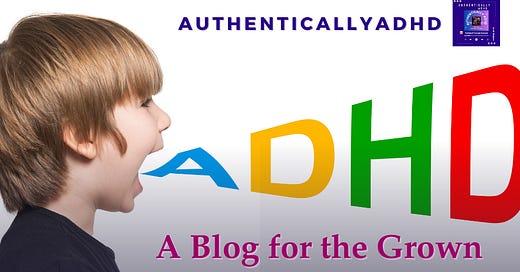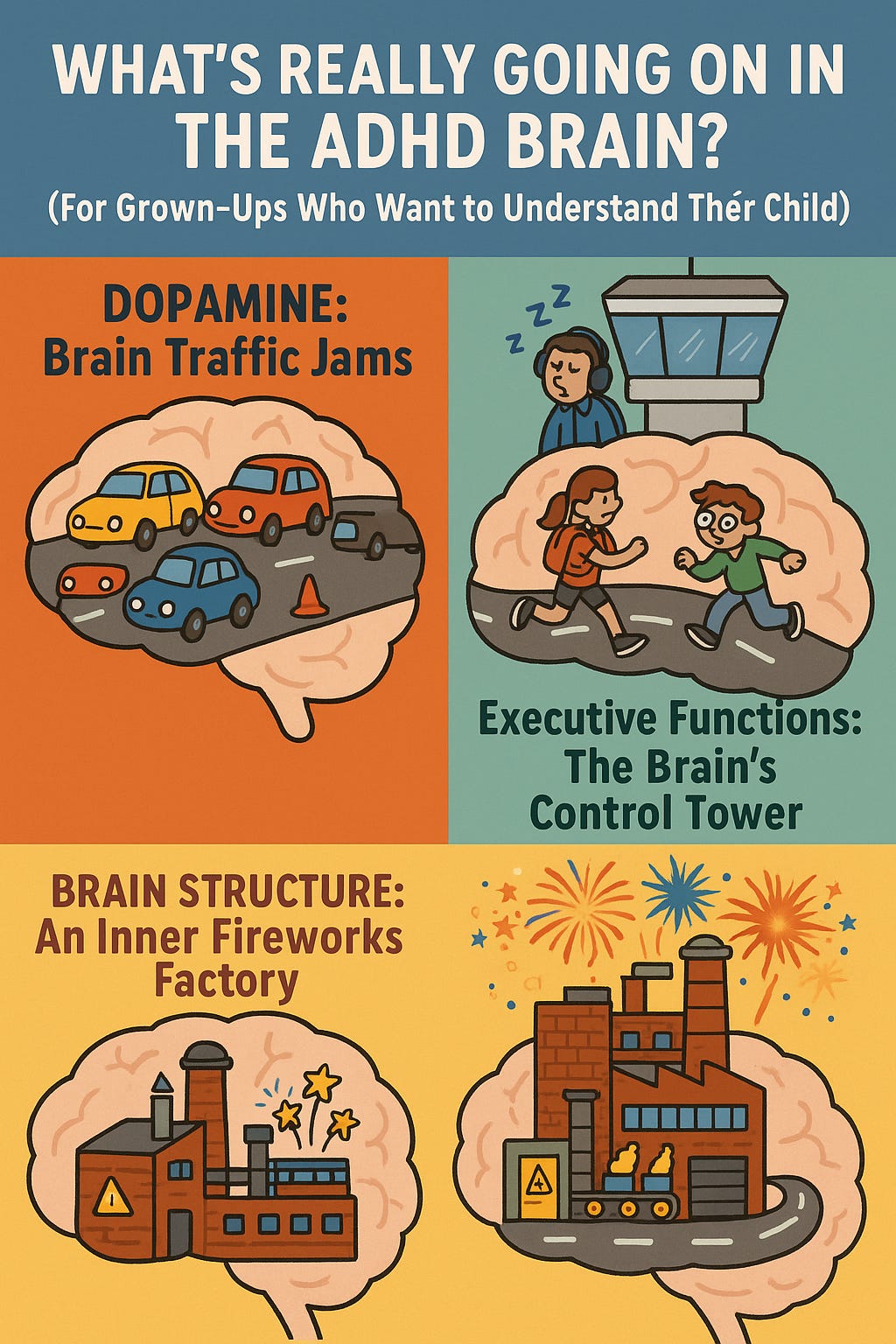A Blog for the Grown Ups: What’s Really Going On In My Kids ADHD Brain? + Tips
(For Grown-Ups Who Want to Understand Their Child)
Hi! Usually, my content is geared toward adults and their ADHD. However, with my expertise in early childhood special education, combined with my extensive research on neurodiversity topics, I have been inspired to create more content for grown-ups with kids who have neurodiversity.
Understanding ADHD is not as straightforward as simply ticking off a few symptoms from a checklist. There’s a lot going on beneath the surface, especially in the brain. For parents, caregivers, and anyone interacting with a child with ADHD, understanding what’s happening neurologically can unlock empathy, patience, and more effective ways to support them.
In this blog, we’ll explore what’s really going on inside the ADHD brain—using kid-friendly metaphors, breaking down complex neuroscience concepts, and providing research-backed strategies that you can use to help your child thrive.
1. Brain Traffic Jams: Dopamine, Executive Functions, and Brain Structure
To start, imagine that the brain is a busy city. In this city, there are highways (neurons) that need to be clear and moving smoothly so that information can travel efficiently. Now, imagine that in the ADHD brain, the traffic lights (dopamine) aren’t working quite right. Instead of regulating the flow of traffic, they malfunction, making everything move erratically and causing delays. This can cause “traffic jams” in your child’s thoughts, feelings, and actions.
What’s Happening with Dopamine?
Dopamine is often called the brain’s “motivation molecule.” It’s what helps us focus, feel rewarded, and keep our attention on things. In the ADHD brain, there’s a shortage of dopamine, which means it’s harder for your child to stay on track, complete tasks, or feel motivated to do something, especially when the activity isn’t inherently exciting.
Executive Functions: The Brain’s Control Tower
Think of executive functions as the brain’s air traffic control tower. This part of the brain helps us plan, prioritize, and make decisions. But in ADHD, the control tower isn’t always fully operational. This is why your child might struggle with time management, shifting from one task to another, or organizing their thoughts and actions. It’s not that they don’t want to; it’s that their brain is simply having trouble coordinating everything at once.
The Brain Structure: The Prefrontal Cortex
The prefrontal cortex (PFC) is like the CEO of the brain. It’s responsible for higher-level thinking, like making decisions and controlling impulses. In kids with ADHD, this part of the brain develops more slowly or doesn’t work as efficiently. This means that they might act without thinking, have difficulty planning, or struggle to control their impulses. They might seem like they’re not trying, but really, it’s just that their CEO is having a tough time running the show.
2. Not Just Hyper: The 3 Types of ADHD in Children
ADHD is often misunderstood as just "hyperactivity," but it’s much more nuanced than that. In fact, ADHD can be categorized into three types: Inattentive, Hyperactive/Impulsive, and Combined. Understanding these different types can help parents see their child’s behavior in a new light.
Inattentive ADHD: The Daydreamer
Children with the inattentive type of ADHD may appear to be "lost in their own world"—constantly distracted and unable to focus on the task at hand. Think of it like trying to watch a movie with the sound turned off. Your child’s brain may struggle to process and prioritize information, making it hard for them to stay on track with tasks like homework or even following simple instructions.
Real-Life Example: A child may forget to pack their schoolbag, not because they don’t care, but because their brain is overwhelmed by competing stimuli (e.g., thoughts, sounds, and feelings).
Metaphor: Their brain is like a radio that keeps changing stations without them ever finding the right one.
Hyperactive/Impulsive ADHD: The Energizer Bunny
This type is often associated with more visible behavior: constant fidgeting, difficulty sitting still, and speaking out of turn. It’s not that these kids are “bad” or trying to disrupt; it’s simply that their brain is constantly firing on high—almost like a factory that’s running too fast.
Real-Life Example: A child may blurt out answers in class before they’ve fully processed the question, not because they’re not paying attention, but because their brain is too fast to stop them.
Metaphor: It’s like having a factory inside their brain where the machines are running full speed ahead, and there’s no off switch.
Combined ADHD: The Mix of Both Worlds
Some children have a combination of inattentive and hyperactive/impulsive symptoms. It’s like being stuck in both worlds simultaneously. Their brains may seem like they’re juggling too many things at once—constantly shifting between being lost in thought and being unable to sit still.
Real-Life Example: A child may start an activity, get distracted halfway through, then get frustrated and lose interest before finishing what they started.
Metaphor: It’s like juggling flaming torches—trying to stay on task while the fire (distraction or impulsivity) keeps jumping from one thing to another.
3. ADHD and Executive Dysfunction in Kids: Task Initiation, Working Memory, Emotional Regulation
At the heart of ADHD are challenges with executive functions, which are the mental processes that help us organize, plan, and control our behavior. These include:
Task Initiation: The Start Button That’s Hard to Press
Imagine trying to start a video game, but the controller’s start button is broken. That’s how kids with ADHD feel when they try to begin a task. The motivation or ability to start something feels elusive, and they often need extra pushes to get going.
Real-Life Example: Your child might procrastinate on their homework, not because they don’t care, but because their brain has trouble overcoming the initial inertia of starting the task.
Metaphor: It’s like trying to get a heavy train moving—once it starts, it runs smoothly, but it’s tough to get that initial momentum.
Working Memory: The Brain’s Sticky Note System
Working memory is like a mental sticky note that helps us remember what we’re doing and why we’re doing it. In ADHD, this system is often unreliable. Your child may forget what they’re supposed to be doing in the middle of a task, even if they just started it a few minutes ago.
Real-Life Example: Your child might start a chore, get distracted, and forget to finish it, leaving the room a mess.
Metaphor: It’s like trying to hold onto an idea while juggling a bunch of other things—everything keeps slipping away.
Emotional Regulation: The Rollercoaster of Feelings
For children with ADHD, emotional regulation is often like being on a rollercoaster ride without a seatbelt. Their emotions can swing from high to low, and they may have trouble calming down after getting upset. This can make everyday situations—like not getting a toy they want or being asked to clean up—a huge emotional challenge.
Real-Life Example: A child might have an emotional meltdown over something small because their brain has trouble regulating their emotional response.
Metaphor: Their emotions are like fireworks—explosive and hard to control, but once they go off, the aftermath can be overwhelming.
4. Sensory Overload and Emotional Outbursts: Why Regulation is So Hard
The ADHD brain is not just struggling with attention—it’s also struggling to handle sensory input. Sensory overload happens when too much information floods the brain at once, causing a "traffic jam" in their sensory processing system.
Polyvagal Theory: The Nervous System’s Brake and Gas Pedal
Polyvagal theory explains how our nervous system responds to stress. In kids with ADHD, their fight-or-flight response (sympathetic nervous system) can be overly sensitive. When this happens, their brain might go into overdrive, making it hard for them to stay calm.
Real-Life Example: A loud classroom or crowded space might cause your child to act out or have a meltdown.
Metaphor: It’s like trying to drive a car with both the brake and the gas pedal pressed at the same time.
Window of Tolerance: The Zone Where We Can Cope
The "window of tolerance" is the range of stress levels where we can function without becoming overwhelmed. Kids with ADHD may have a smaller window—meaning they can become dysregulated more easily.
Real-Life Example: When your child is in a stressful situation, they might react strongly to minor things, like being asked to do a task they don’t want to do.
Metaphor: It’s like trying to balance on a tightrope—if the tension gets too high, they’ll fall off.
Trauma-Informed Lenses: Sensitivity to Stress
Many children with ADHD may have experienced trauma or are highly sensitive to stress. This means that even normal situations can feel overwhelming and trigger emotional outbursts.
Real-Life Example: A child may react aggressively or emotionally when they feel criticized, not because they’re being defiant, but because their nervous system is on high alert.
Metaphor: It’s like being in a house where the walls are paper-thin—every noise or change feels like it’s amplified.
Actionable Tips for Parents:
Create a Routine: Kids with ADHD thrive in structured environments. Make sure their daily routine is predictable, with clear expectations and time for breaks.
Use Visual Reminders: Use charts, schedules, or sticky notes to help your child remember tasks and stay on track.
Practice Calming Techniques: Teach deep breathing or mindfulness exercises to help your child self-regulate when they’re feeling overwhelmed.
Limit Sensory Input: Be mindful of overstimulating environments. If possible, create a calm space where your child can retreat when they feel overstimulated.
Praise Effort, Not Just Results: Focus on the effort your child puts into tasks, not just the outcome. This helps them feel motivated and builds their self-esteem.
By understanding the neuroscience behind ADHD, you can better support your child with strategies tailored to their unique needs. Every brain is different, but with patience, empathy, and these tips, you can help your child navigate their world with greater ease.








I shared this with my sister ❤️ her daughter was recently diagnosed